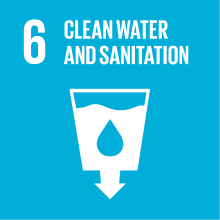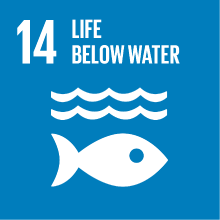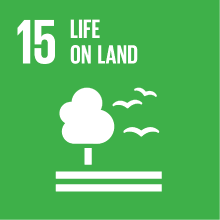PHYSICAL GEOGRAPHY AND GEOMORPHOLOGY-1
- Academic year
- 2025/2026 Syllabus of previous years
- Official course title
- GEOGRAFIA FISICA E GEOMORFOLOGIA-1
- Course code
- CT0624 (AF:608370 AR:292954)
- Teaching language
- Italian
- Modality
- On campus classes
- ECTS credits
- 6
- Degree level
- Bachelor's Degree Programme
- Academic Discipline
- GEO/04
- Period
- 1st Semester
- Course year
- 2
- Where
- VENEZIA
- Moodle
- Go to Moodle page
Contribution of the course to the overall degree programme goals
The course Physical Geography and Geomorphology is part of the core curriculum of the Environmental Sciences Bachelor’s Degree Programme, within the Learning Area “Earth Sciences”. It provides students with fundamental knowledge and skills to understand the morphological evolution of the Earth’s surface and its relationship with environmental and climatic processes, both on geological and anthropogenic timescales.
The course directly contributes to achieving the educational objectives of the Degree Programme, providing:
• basic knowledge of major geomorphological processes and associated landforms;
• skills in observing, analysing and interpreting the physical landscape using geographic data and tools;
• cross-disciplinary competencies in the use of digital tools (GIS, programming languages) for geomorphological and environmental analysis.
The course is divided into two modules:
PHYSICAL GEOGRAPHY AND GEOMORPHOLOGY – 1: theoretical module (30 hours) introducing the key concepts of geomorphology, offering an overview of major physical environments and the processes driving their evolution.
PHYSICAL GEOGRAPHY AND GEOMORPHOLOGY – 2: practical module (18 hours) consisting of guided exercises, in which students apply their acquired knowledge using Python and QGIS, developing operational and analytical skills useful for professional or research careers.
Through this course, students will acquire a solid theoretical and practical foundation for understanding and analysing the physical Earth system, in line with the learning outcomes of the Degree Programme and the interdisciplinary approach typical of Environmental Sciences.
Expected learning outcomes
Knowledge and understanding
Students will be able to:
• describe the main geomorphological processes (e.g., erosion, transport, deposition, tectonics, glacial and coastal activity);
• understand the interactions between climatic, geological, hydrological, and biological factors in geomorphological systems;
• analyze the influence of human activities on the morphological evolution of landscapes;
• place observed landforms in different geological and climatic contexts, including from a historical perspective.
Applying knowledge and understanding
Students will be able to:
• recognize and classify the main landforms and interpret their genesis;
• assess the cause-effect relationships between morphology and physical processes;
• identify geomorphological issues in real-world contexts (e.g., slope instability, coastal erosion risk, impacts from extreme events);
• use digital tools (GIS, Python) to analyze spatial data and build geographical representations of environmental phenomena.
Independent judgment
Students will develop the ability to:
• critically evaluate geomorphological data collected in the field or from digital sources;
• contextualize the interpretation of landscapes in relation to environmental and historical factors;
• integrate interdisciplinary knowledge in territorial analysis.
Communication skills
By the end of the course, students will be able to:
• write technical reports clearly and coherently, using appropriate scientific terminology;
• present geomorphological analyses in oral or written form, based on data and observations;
• interact effectively in multidisciplinary contexts related to environmental management.
Learning skills
The course encourages the development of:
• a scientific mindset focused on observation, analysis, and empirical verification;
• skills for the autonomous use of bibliographic sources, geospatial datasets, and software tools for continuous learning;
• the ability to approach new environmental challenges with a systemic and critical thinking perspective.
Pre-requirements
In particular, the following are required:
• general knowledge of geology and Earth sciences, to understand the evolution of the Earth’s surface and geodynamic contexts;
• basic skills in geography and cartography, useful for interpreting thematic maps and digital terrain models;
• basic knowledge of chemistry and physics, necessary to understand the physical and chemical processes that influence geomorphological dynamics.
These skills are usually acquired through the following first-year courses:
• Fundamentals of Earth Sciences;
• General Physics;
• Foundations of Mathematics with Exercises;
• General and Inorganic Chemistry with Laboratory.
An aptitude for observing and analysing the landscape is also useful, as well as basic familiarity with digital and IT tools, which will be further developed during the practical component of the course.
Contents
The following topics will be covered:
• Introduction to geomorphology: definition of the discipline, history of geomorphology, and its relevance in environmental sciences. Relationships between the geosphere, hydrosphere, and biosphere in Earth’s physical systems.
• Weathering processes and the role of soils: mechanical breakdown and chemical alteration of rocks. Soil formation and their importance in landscape transformation and stability.
• Surface and groundwater hydrology: precipitation cycles, runoff, infiltration, and aquifers. The role of water in morphological shaping of catchments and slope dynamics.
• Slope dynamics and landslides: mechanisms of slope instability, types of landslides, and triggering factors. Case studies including the Vajont landslide will be analyzed.
• Fluvial systems: river morphology, sediment transport processes, meander dynamics, and watershed functions. Identification of landforms and active processes in fluvial landscapes.
• Coastal environments: beach evolution, littoral dynamics, sedimentation, and erosion. Study of coral reefs and their vulnerability to climate change and human impacts.
• Glacial and periglacial environments: glacial processes, glacier formation, sediment transport and shaping. Analysis of typical glacial landforms and associated deposits.
• Aeolian processes: sediment transport and deposition by wind. Formation of dunes, deserts, and aeolian landforms, with examples from arid and coastal environments.
• Geomorphology and climate change: impacts of past and present climate change on geomorphic processes. Discussion of interactions between landforms and climate in various contexts.
The course also includes a practical component focused on the analysis of a coastal environment, where students will use QGIS and Python to explore real geomorphological issues and develop a technical report based on a case study. This activity allows students to apply theoretical knowledge in a real-world analytical context.
Referral texts
• Bierman, P. R., Montgomery, D. R., Key Concepts in Geomorphology, Freeman & Company, 2021. Some copies are available at the Science Area Library. Purchasing the textbook is not required to take the exam.
Materials provided by the instructor
• Slides and supplementary materials provided by the instructor will be available on the Moodle platform at the end of each lesson cycle.
Additional readings (optional)
• Further bibliographic references or online resources may be suggested during the course for specific topics.
Assessment methods
The written test consists of 33 multiple-choice questions (1 point each, no penalty for incorrect answers), to be completed in 1.5 hours. Questions may cover any content presented during lectures or provided as supplementary materials on Moodle.
Key rule: Anything uploaded to Moodle may be included in the exam.
To take the written test, students must submit the technical report developed during the practical part of the course (Physical Geography and Geomorphology – 2), which involves the use of QGIS and Python to analyze a coastal case study.
The final grade will be calculated as a weighted average of:
• written test (weight 2/3);
• technical report from the practical activities (weight 1/3).
Example of final grade calculation:
• Written test score: 27/30
• Lab report score: 30/30
• Final grade = (27 × 2/3) + (30 × 1/3) = 18 + 10 = 28
Sample tests will be provided during the course to help students become familiar with the structure and difficulty of the exam.
This assessment method is designed to evaluate:
• theoretical knowledge of geomorphological processes (Module 1 – Written test);
• ability to apply tools and concepts to real-world cases (Module 2 – Report);
• communication and synthesis skills in writing the report (Module 2 – Report);
• autonomous learning skills and effective use of provided materials (Module 1 – Written test).
Type of exam
Grading scale
The evaluation takes into account the number of correct answers, as well as the student’s ability to accurately identify key concepts in physical geography and geomorphology.
• 18–22/30: sufficient but fragmented knowledge. Limited understanding of major geomorphological processes, with uncertainty in distinguishing similar concepts or applying them correctly. Correct answers: 18–22.
• 23–26/30: fair and consistent knowledge. Good understanding of the course content and ability to recognize relationships between concepts, examples, and case studies. Correct answers: 23–26.
• 27–30/30: complete and in-depth knowledge. Excellent mastery of theoretical content, with precise terminology and conceptual associations. Correct answers: 27–30.
• 30 cum laude: outstanding performance, with at least 31 correct answers out of 33. The student demonstrates advanced knowledge, terminological precision, and critical thinking in selecting answers.
Note: The grade awarded for the theoretical component will contribute to the final weighted average of the course, calculated as follows:
• 2/3 theoretical exam (multiple-choice test)
• 1/3 practical exam (technical report developed in the “Physical Geography and Geomorphology – 2” module)
The grading criteria for the practical component are provided in the corresponding section of the syllabus for the “Physical Geography and Geomorphology – 2” module.
Teaching methods
• Lectures (module “Physical Geography and Geomorphology – 1”), focused on acquiring theoretical knowledge of geomorphological processes and the main physical environments of the Earth.
• Guided practical sessions (module “Physical Geography and Geomorphology – 2”), aimed at applying theoretical knowledge through digital tools and real-world environmental case studies.
During lectures, the instructor uses original slides, specifically designed to visually and concisely illustrate key concepts. The slides are made available in PDF format on Moodle at the end of each class, along with supplementary notes that summarize the content discussed in class.
To ensure accessibility, protected categories of students (as defined by the University) will have access to video recordings of the lessons, which will be uploaded to Moodle.
The adopted methods align with the educational objectives of the course and aim to develop both theoretical knowledge of geomorphological phenomena and the ability to apply this knowledge to landscape and spatial data analysis.
In addition to the materials presented in class, the following will be made available on Moodle:
• Supplementary videos on specific environments (e.g., coasts, rivers, glaciers);
• Thematic podcasts to support individual study;
• Optional self-assessment materials (tests and sample questions).
These teaching methods are designed to foster active and flexible learning, adaptable to different educational needs and levels of preparation, also thanks to the integrated use of the University’s Moodle platform.
Further information
Ca’ Foscari complies with Italian law (Law 17/1999; Law 170/2010) regarding the support services and accommodations available to students with disabilities or specific learning disorders. If you have a motor, visual, hearing, or other disability (Law 17/1999), or a specific learning disorder (Law 170/2010), and require support (in-class assistance, technological aids for exams or individualized exams, accessible-format materials, note-taking support, specialized tutoring, interpreters, or other services), please contact the Disability and SLD Office at: disabilita@unive.it.
2030 Agenda for Sustainable Development Goals
This subject deals with topics related to the macro-area "Natural capital and environmental quality" and contributes to the achievement of one or more goals of U. N. Agenda for Sustainable Development



